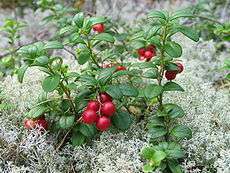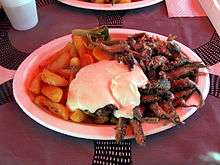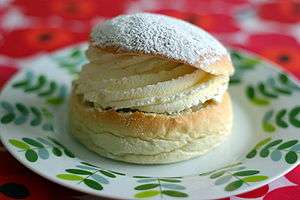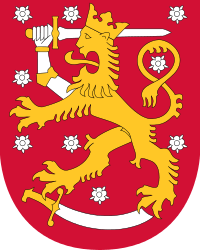Finnish cuisine

Finnish cuisine is notable for generally combining traditional country fare and haute cuisine with contemporary continental style cooking. Fish and meat (usually pork, beef or reindeer) play a prominent role in traditional Finnish dishes in some parts of the country, while the dishes in others have traditionally included various vegetables and mushrooms. Refugees from Karelia contributed to foods in other parts of Finland.[1]
Finnish foods often use wholemeal products (rye, barley, oats) and berries (such as blueberries, lingonberries, cloudberries, and sea buckthorn). Milk and its derivatives like buttermilk are commonly used as food, drink or in various recipes. Various turnips were common in traditional cooking, but were replaced with the potato after its introduction in the 18th century.
Characteristics
In former times, the country's harsh climate meant that fresh fruit and vegetables were largely unavailable for nine months of the year, leading to a heavy reliance on staple tubers (initially turnip, later potato), dark rye bread and fermented dairy products, occasionally enlivened with preserved fish and meat. Traditionally, very few spices other than salt were available, and fresh herbs like dill were limited to the summer months. Many Finnish traditional dishes are prepared by stewing them for a long time in an oven, which produces hearty but bland fare. Forests and lakes were historically a major source of food, and produce from forests currently accounts for the distinctive traits in Finnish cuisine. The simplicity of traditional Finnish food has been turned into an advantage by shifting the emphasis to freshness. Modern Finnish restaurateurs now blend high-quality Finnish products with continental cooking techniques. This approach helped Helsinki's Chez Dominique to receive two Michelin stars in 2003 (the restaurant closed in 2013).
Internationalization brought imported goods. As pasta, pizza, kebab, and hamburgers were integrated into Finnish menus, they displaced some traditional everyday dishes like cabbage casserole or herring fillets, which some consider inferior. As of the 20th century, when the majority of Finnish women entered the workforce, many traditional dishes that require long preparation time are reserved for holidays.
Even with modern agriculture and transportation, food remains expensive in Finland relative to other European countries. This is notwithstanding the effect of accession to the European Union in 1995. The consequent elimination of trade barriers led prices of products like grains, meat, and milk to drop as much as 50%.[2] Before that, heavy taxes and outright bans on imports that competed with local produce severely limited the availability of foreign or unseasonal food. Nowadays Finnish supermarkets and restaurants provide a variety of food from all over the world.
Finnish cuisine is very similar to Swedish cuisine. In fact, Swedish dishes like Janssons frestelse (janssoninkiusaus), pyttipannu, and gravlax are common in Finland. The overarching difference is the Finns' preference for unsweetened foods. For example, while traditional Swedish rye bread includes plenty of syrup and spices, Finnish rye bread is unsweetened, even bitter. Finnish cuisine also bears some resemblance to German and Russian cuisines.[3] Sausages and buttered bread (like Butterbrot), and kiisseli (kissel) and karjalanpiirakka (cf. pirozhki) are similar to their respective German and Russian counterparts. Finnish recipes, however, tend to favour fresh ingredients over canned or pickled foods as fresh vegetables, fish, and meat are available throughout the year.[4]
Finnish food
Meats from Finland
The most popular meats in Finland are pork (33.5 kg/year/person in 2005), beef (18.6 kg), chicken, and duck (13.3 kg).[5] Approximately one third of this is eaten as sausage (makkara), which is mostly made from pork but often mixes in other meats as well.[6]
In addition to domesticated animals, there are long traditions of hunting and fishing in Finland. The hunters focus on deer, moose and bear, but small game such as hare, duck and grouse are popular. Approximately 70,000-80,000 moose are culled yearly producing significant amounts of meat. Due to very strict food hygiene regulations, moose meat is mainly consumed within households and is rarely obtainable in restaurants. Finnish restaurants are also accustomed to serving reindeer steak for special holidays. .
Berries

Arctic wild berries are distinctively featured in Finnish cuisine with their strong flavor and high nutrient content. Traditionally, they were eaten fresh in summer and dried at other times of year. It is still quite common to go picking berries straight from the forests. Wild raspberries, bilberries and lingonberries (cowberries) are found in almost every part of Finland, while cloudberries, cranberries, arctic brambles and sea buckthorns grow in more limited areas. The intensely flavored wild strawberry (metsämansikka) is a seasonal delicacy decorating cakes, served alone, with cream, or with ice cream.
Today, berries are no longer dried for winter consumption but usually frozen. They may be used as ingredients, or eaten on their own, for example, with porridge and sugar. Homemade berry juices and jams are common, especially among older people. While berries are most often used for desserts, they are also served with meat, especially the sour lingonberry relish.
Bilberry kiisseli and pie, made from wild bilberries (Vaccinium myrtillus), are traditional Finnish desserts. Bilberries are frequently used in Finnish cuisine, both as an ingredient, such as bilberry pie, and also served with cream or ice cream. They are often used on top of viili and other yogurt-type dishes.
Fish


Lakes in Finland provide many opportunities for fishing and fish has always been an important protein source. Numerous methods of preparing fish are used, including frying, boiling, drying, salting, fermenting, cold smoking or simply slicing sea fish and eating it raw. Salmon is a popular choice, both as kylmäsavustettu lohi: cold smoked salmon, lox, or served raw with lemon juice as graavilohi (gravlax in Swedish). It is common to smoke any types of fish, like salmon, zander, pike, perch and Baltic herring. A popular dish among the Swedish-speaking population is smoked herring (Finnish: savusilakka, Swedish: böckling). There are many styles of pickled herring which is a common appetizer and also served around Midsummer accompanied by small potatoes called uusiperuna (nypotatis in Swedish) which literally means 'new potato', usually the first harvests of potato. Whitefish and vendace roe are Finnish delicacies served on top of a toast or with blinis. Crayfish can be found in many lakes and streams in Finland and, in August especially, the Swedish-speaking population often arranges parties centered around eating crayfish and drinking.
Mushrooms

Various species of mushrooms grow in abundance in Finnish forests and false morels start the season in spring and are used in creamy dishes. Chanterelles and ceps pop up after Midsummer and are popular in the whole country, while in eastern Finland almost all edible fungi are consumed, including milkcaps and russulas. Most of the mushroom recipes originate from Russia, since Finns used mushrooms in coloring fabrics rather than as food. Mushrooms are used in soups, sauces, stews, pie fillings, or simply fried in a pan with onions as a side dish. They are preserved for the winter by pickling or drying. Chanterelles are frequently featured in Finnish haute cuisine with their relatives winter chanterelles which often end the season. Just like berry picking, mushroom hunting is also a popular outdoor activity among Finns.
Bread
Dark and fiber-rich ruisleipä, rye bread is a staple of the Finnish diet. Breads are made from grains like barley, oat, rye and wheat, or by mixing different grits and flours. For example, sihtileipä is made of a combination of rye and wheat. There is also a variety of flat breads called rieska, like maitorieska (milk flatbread), ryynirieska with barley grits from Savonia, läskirieska (lard flatbread) a somewhat flat barley bread with pieces of lard from Western coast, and perunarieska (potato flatbread). In Kainuu, North Finland, the flatbreads are very flat and baked on naked flame. Näkkileipä, crisp rye bread, is also common. Famines caused by crop failures in the 19th century caused Finns to improvise pettuleipä or bark bread,[7] bread made from rye flour and the soft phloem layer of pine bark, which was nutritious, but rock-hard and anything but tasty. It was eaten also during the Second World War, and the tradition of making this bread has had a minor come-back with claims of health benefits.
Porridges
The Finnish breakfast traditionally includes a substantial portion of porridge. Rolled oats, rye or multi-grain porridge are most common. However, there are other options such as the milk-based mannapuuro (semolina-milk porridge) and helmipuuro (starch grain-milk porridge). Porridges are often eaten with milk, sugar, butter or berry kiisseli. The Christmas season introduces milk-based rice porridge (riisipuuro), sprinkled with cinnamon and sugar and often topped with prune kiisseli (luumukiisseli).
Beverages
Water and coffee are the most common drinks in Finland, but during meals milk and sour milk (piimä, a fermented milk) are popular too, even among adults. Coffee is often drunk several times a day and served everywhere, and tea is available in most homes. There are several types of home-brewed alcoholic beverages, sima (mead), sahti (traditional beer) and kilju (sugar wine, a notorious drink traditionally fermented without flavoring). Some people distill pontikka (Finnish moonshine) even though it's illegal. Famous brands of spirits include Koskenkorva (vodka-like clear spirit) and a salmiakki flavored shot Salmiakkikossu, Jaloviina (cut brandy), Finlandia Vodka, and Marskin ryyppy (Marshal Mannerheim's shot). Around Christmas time a type of mulled wine called glögi is served, also often as a non-alcoholic version. Many berries are used to season liqueurs, e.g. cloudberry liqueur and there are wines produced from red and black currants. A national specialty would be multiple brands of flavored hard ciders (as in Sweden) and long drink mixes with the pet name lonkero, which was originally a gin and grapefruit soda long drink.
The Finnish beer scene is dominated by pale lagers. The most popular local brands are Koff, Lapin Kulta, Karjala, Olvi and Karhu and their taste is rather similar to the Danish counterparts like Carlsberg and Tuborg; soft and a bit sweet. Non-alcoholic beer has also become a popular alternative during recent years. Kotikalja (similar to Russian kvass) is the traditional small beer. Kotikalja is a malty, sugar-containing sweet beer fermented only for carbonation, thus its alcohol content is low enough (<1.2%) to be served as a soft drink. Hops are often absent. Fresh kotikalja is unfiltered, cloudy and cannot be stored. A Finnish beer specialty is sahti, a traditional ale flavoured with juniper berries.
Desserts

- Pulla, sweet, cardamom-flavored bread eaten with coffee or as dessert
- Cinnamon rolls (korvapuustit) - pulla made into a roll with cinnamon and sugar
- Golden cloudberry dessert
- Kiisseli – water, sugar, berry juice and berries (nowadays often canned or frozen) thickened with potato starch flour, served with milk/cream and sugar. These may be less liquid than drink-like mustikkakeitto (Swedish blåbärssoppa), depending on preparation, but not gelatinous.
- Vispipuuro (whipped porridge) a sweet pink dessert porridge with lingonberries or other berries, served with milk and sugar.
- Runeberg torte named after a national poet J.L. Runeberg and served on his memorial day on the 5th of February.
- Rönttönen pastry with lingonberry filling
Sweets
- Salmiakki – salty black liquorice candy
- Fazer Sininen milk chocolate
- Wood tar (terva) flavoured candy, such as Terva Leijona
Examples of Finnish dishes
Note that the term perinneruoka ("traditional dish") is often applied to specialties that are rarely eaten on a daily basis. These are often regional, associated with the older generations or confined to a specific holiday (for example, mämmi in Easter or most Christmas dishes), and most people eat them rarely or not at all. To contrast with perinneruoka, the term kotiruoka ("home-made food", even if in a restaurant) is applied to daily staple dishes. Meatballs, pea soup and rye bread are examples of such staples.
The following list is a sample of typical dishes traditionally consumed in Finland.
Typical Finnish dishes

- Kaalikääryleet – cabbage rolls
- Game food. – Moose, deer, grouse, duck, hare, etc... dishes. Rarely attainable in restaurants. Common amongst those whose hobby is hunting.
- Hernekeitto – pea soup, usually served on Thursday along with a dessert pancake
- Leipäjuusto, alternate names hiilikko and juustoleipä – a fresh cow's milk cheese
- Viili – a yoghurt-like fermented milk product
- Perunamuusi – Mashed potato, a common side dish
- Lihapullat – Finnish meatballs, often with gravy sauce
- Palvikinkku and palviliha – Smoked ham or beef
Holiday specialties
Shrove Tuesday

- Hernekeitto - Pea soup made with ham and traditionally served with mustard.
- Laskiaispulla – (Shrovetide pulla) filled with whipped cream and almond paste or jam
Easter
- Mämmi Easter Dessert Pudding: sweetened oven-baked rye malt porridge, served with sugar and milk or cream, available frozen around the year. In the Catholic era it was Lent food and also served on Good Friday.
- Pasha a dessert made of quark, butter, eggs and spices, originates from Russia
Vappu (May Day)
- Sima (mead) home-made or purchased
- Munkki (deep-fried pulla dough coated in sugar similar to doughnuts)
- Tippaleipä (May Day fritters) analogous to funnel cake
Christmas
- Joulupöytä "Christmas table" consists of many dishes almost entirely reserved for Christmas and some side dishes
- Glögi (mulled wine) is served around holiday season
Regional cuisine
Lapland

- Sautéed reindeer (poronkäristys)
- Lohikeitto salmon soup with cream
Kainuu
- Rönttönen, pastry with lingonberry filling (PGI protection under EU law)
- Smoked meat soup
- Kainuun Juustoleipä, Bread Cheese
- Vendace fish soup
- Pettuleipä (Pettu-bread), a bread made from rye flour and pine bark
Karelia
- Karelian pasties popular throughout the whole of Finland
- Karelian Stew/Hot Pot often part of Christmas menu everywhere in Finland
- Sultsina sold at the market square in Joensuu and other places in the area
Savonia
- Kalakukko fish pasty loaf
- Mykyrokka blood dumpling soup
- Lörtsy pastry filled with sour or sweet fillings (meat, vegetable or jam)
Ostrobothnia and Åland
Due the location on the West coast, the cuisine has some local specialities.
- Klimppisoppa flour dumpling soup
- Åland's pancake typically made of leftover porridge and served with plum soup
- Swedish svartbröd "black bread" is eaten in Swedish-speaking Åland; similar dark bread, known as skärgårdslimpa ("islander's bread", referring to Åland), is made on southern coast, and in Malax on the Ostrobothnian coast (malaxlimpa). This bread, coloured dark brown, is made from rye and contains a substantial quantity of dark syrup.
Other specialties
- Mustamakkara – Blood sausage from Tampere
- Rössypottu from Oulu (mixed blood pudding and pork stew)
- Hapanvelli (rye and pea porridge) from Virolahti
- Kakko, a type of white bread baked mostly in the Satakunta region[8]
Meals

There are three meals per day: breakfast, lunch and dinner. In all primary and secondary schools, including high school, a hot free lunch is served as part of Finland's welfare state system. Lunch, eaten around noon, is usually a warm meal, although some people may select a lighter meal such as a sandwich or a salad. Taking a lunchbox is not as common as elsewhere in Europe.[9] Lunch typically consists of a single course with optional side salad, bread and dessert. Many workplaces have a lunch restaurant, and if not, employers often give lunch vouchers. Restaurants often have a separate lunch menu for this purpose. In the evening, the dinner is usually a hot meal, again with sides. Meals are usually single-course, commonly consisting of meat of some sort (pork, lamb, chicken, beef) and potatoes, rice or pasta with the meat. Soups, such as pea soup or fish soup, are not considered appetizers only, but may be served as lunch or dinner, and they are correspondingly heavier and come in larger portions.
Breakfast
Breakfast is seen as a substantial meal and usually consists of open sandwiches. The sandwich is often buttered, with savoury toppings such as hard cheese or cold cuts. Sour milk products such as yoghurt or viili are also common breakfast foods, usually served in a bowl with cereals such as corn flakes, muesli, and sometimes with sugar, fruit or jam. A third food that is commonly eaten at breakfast is porridge (puuro), often made of rolled oats, and eaten with a pat of butter (voisilmä, lit. "butter eye") or with milk, or fruit or jam, especially the sort made of raspberries or strawberries (sometimes lingonberries). Drinks are milk, juice, tea, or coffee.
Coffee breaks
Finland has the highest coffee consumption per capita in the world, averaging 12 kg of coffee per person annually.[10] It is typical for a Finn to drink coffee continuously throughout the day, often accompanied by a sweet bun or a sandwich. Most workplaces allocate time for coffee breaks and serving coffee is an inevitable part of any visit to a private home.
Criticism
In 2005, Finnish cuisine came under heavy fire from two leaders of countries renowned for their cuisine. The Italian prime minister Silvio Berlusconi claimed that "I've been to Finland and I had to endure the Finnish diet so I am in a position to make a comparison." Berlusconi started his anti-Finnish food campaign in 2001. He went on: "The Finns don't even know what Parma ham is." This followed the initial decision by the European Commission to establish the European Food Safety Authority in Helsinki. On the 4th of July 2005 French President Jacques Chirac claimed that "After Finland, [Britain is] the country with the worst food." [11][12]
After Jacques Chirac's and Silvio Berlusconi's critiques, some international food reporters answered:
"Chirac and Berlusconi are wrong! Finnish cuisine is much more international than I expected. I have eaten very good food in wonderful restaurants, visited market places and enjoyed in good cafeterias. Cheese is very good in Finland. I also love Finnish cloudberry and smoked fish." (Ute Junker, Australian Financial Review Magazine, Sydney, Australia)
"Food in Finnish restaurants is extremely good. Especially I love Finnish salmon, mushroom soup and desserts. I have also got very good Finnish wines. The worldwide reputation of Finnish cuisine isn't very good – but it should be!" (Liliane Delwasse, Le Figaro, Paris, France)
"I have eaten only good food in Finland. Food in Finland is very fresh. Bread, berries, mushrooms and desserts are very delicious. Finnish berries (especially cloudberry), salmon, cheeses and reindeer should be available in London, too." (April Hutchinson, Abta Magazine, London, England).
Finnish pizza chain Kotipizza won the 2008 America’s Plate International pizza contest in New York, while Italian-American pizza came in second. They named their award-winning smoked reindeer pizza Berlusconi as symbolic payback for the critique Finnish cuisine had received from the Italian prime minister earlier.[13]
See also
References
- ↑ Tolvanen, Kristiina. "A Nation in Transition: The Resettlement of the Karelian Evacuees". Department of Translation Studies, University of Tampere. Retrieved 12 November 2013.
- ↑ Tietoaika 2/2005: EU:n tuoma hintaetu on tallella
- ↑ "Finnish Food". Fresh! From Finland. Retrieved 12 November 2013.
- ↑ http://publications.theseus.fi/bitstream/handle/10024/12258/Hyrri.pdf?sequence=1
- ↑ "www.vesijalanjalki.org: liha". Retrieved 27 November 2014.
- ↑ http://www.wigren.sci.fi/yritys.html
- ↑ "Famine Bread". Retrieved 27 November 2014.
- ↑ "Pakarin pitkän iän salaisuus piilee kakossa". yle.fi (in Finnish). Yle. August 12, 2011. Retrieved July 30, 2014.
- ↑ "Englantilainen vs. suomalainen ruoka eli friteerattua Mars-patukkaa ja unohdettuja metsän antimia - Makutarinoita". Makutarinoita. Retrieved 27 November 2014.
- ↑ Soria, Claudia. "Coffee Consumption Per Capita Worldwide". IndexMundi Blog. Retrieved 12 November 2013.
- ↑ McIntosh, Neil (July 4, 2005). "Chirac shares a joke at Britain's expense". The Guardian. London. Retrieved May 2, 2010.
- ↑ http://today.reuters.co.uk/News/newsArticle.aspx?type=oddlyEnoughNews&storyID=2005-06-21T132359Z_01_SPI148241_RTRIDST_0_OUKOE-ITALY-FINLAND-BERLUSCONI.XML
- ↑ "Reindeer Pizza Named after Berlusconi". Retrieved 27 November 2014.
External links
| Wikibooks Cookbook has a recipe/module on |
- Food from Finland
- Mediaeval Food from Finland from the Hotel and Restaurant Museum On the museum website can be found menus over the last century, which shows the food available in Finland.
